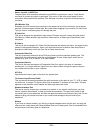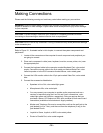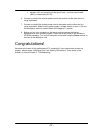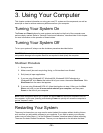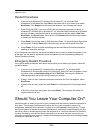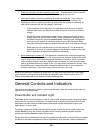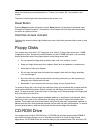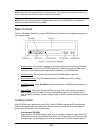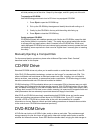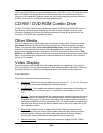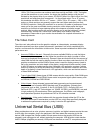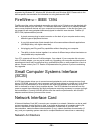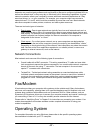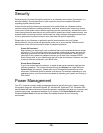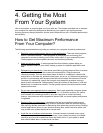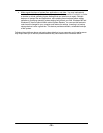
- 23 -
will slide partway out of the drive. Grasp it by the edges, and lift it gently out of the slot.
Tray-equipped CD-ROM:
Use the following procedure to load a CD into a tray-equipped CD-ROM:
1. Press Eject to open the CD-ROM tray.
2. Pick up the CD-ROM by the edges and identify the side with writing on it.
3. Gently lay the CD-ROM in the tray with the writing side facing up.
4. Press Eject to close the CD-ROM tray.
Caddy-equipped CD-ROM
CD-ROMs equipped with caddies operate much like the slot CD-ROMs, except the disk
must first be placed in a protective “caddy.” The caddy has a spring-loaded door similar
to a floppy disk and opens when a disk is inserted in the CD-ROM drive. While most
caddy equipped CD-ROM drives have internal spring-actuated covers to protect the front
slot opening, some require that a front cover be “flipped down” manually prior to inserting
the caddy.
Manually Ejecting a Compact Disk
For the manual ejection procedure, please refer to Manual Eject under “Basic Controls,”
described earlier in this chapter.
CD-RW Drive
Standard CD-ROM drives only allow you to read the audio or coded data contained in the CD.
With CD-R (CD-Recordable) technology, content can be “burned” or recorded onto CDs. This
allows individuals and businesses to download content onto CDs, including, but not limited to
backup archives, new products, or personalized audio compilations. CD-R technology is limited
because content burned onto CDs cannot be edited or deleted.
CD-RW technology (CD-Re-writeable) allows you to use special CDs in the same way you might
use a floppy disk, except with a far larger storage capacity. With CD-RW technology you can add,
edit, and delete information on CDs with the same ease as on a hard or floppy disk. Unlike a hard
or floppy disk, burned CD-RW data is non-volatile, meaning it is impervious to magnetic fields and
other phenomena that can adversely impact data stored on floppy or hard disks.
Most CD-R and CD-RW drives closely resemble standard CD-ROM drives and use the same
loading and ejecting procedures outlined above for CD-ROM drives. If your CTL computer
includes a CD-R or CD-RW drive, please refer to the unit's documentation for complete
information on its use. External controls and disk loading procedures on these drives are similar
to the controls on a CD-ROM drive described previously.
DVD-ROM Drive
A DVD disk can hold up to 8.5GB of video, audio or data on each side. This provides enough
storage capacity for over four hours of high quality video with multiple audio tracks as well as
subtitles and interactive menus. Some DVD disks are double-sided, bringing the total storage to



